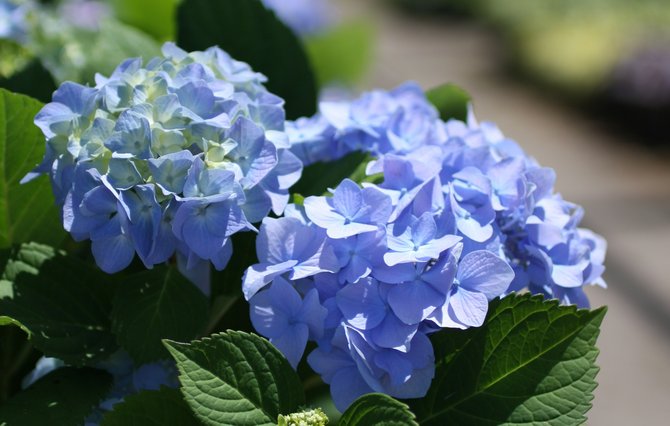Know what to look for when shopping for plants at nurseries this time of year. Photo by Courtesy Flickr/tinyfroglet
Would-be and weekend gardeners are flocking to stores this time of year with hopes of finding already-started plants to put in their gardens. Some of those offerings have been in stores for weeks and now look a bit bedraggled. Often severely marked down, are they really a bargain? What should consumers look for in selecting a plant?
First, choose plants that come from certified organic seeds, which were developed to grow in the home garden, not thousand-acre fields of industrial agriculture.
If not available, the second-best option is to choose heirloom varieties.
Heirloom seeds are called "heirlooms" for a reason. They are treasured because of the flavor, taste, size, color and other characteristics of the plants they produce that make them worth handing down.
Big seed companies are focused on developing hybrids or varieties they can patent. That ensures bigger annual sales because patented seeds must be purchased anew every year. Heirlooms are stable (meaning they produce offspring that resemble the parent), are open pollinated (meaning they are not artificially manipulated) and have at least a 50-year history as a distinct variety.
The giant seed companies go so far as to create genetically engineered seeds that cannot be found in nature. Such genetically modified organisms (GMOs) can contain genes from bacteria, viruses, insects and even animals inserted into their DNA.
GMOs are prohibited in certified organic. So, when purchasing a plant or seeds, you want varieties that are open pollinated (non-hybrid) and untreated (not dyed or contaminated by chemicals, such as anti-fungals), and marked as being either certified organic or heirlooms.
A few companies even sell certified organic heirlooms, but they are extremely rare.
List of Don'ts:
Don't choose tall spindly plants or, conversely, stubby plants that are "woody" on the stems. Both are examples of plants that have exceeded their prime.
Don't choose plants that have leaves that are spotted, off color or rimmed with white (examples of various rots, fungus or other maladies).
Don't buy plants with obvious signs of insect or other attack.
Don't buy plants that have weak root systems: Stick your finger in the pot; if it's wet and the roots are rotting, that's a difficult condition to overcome.
Don't buy plants that have roots that are wound around the inside of the pot or sticking out through the bottom. To replant it, you'll damage the root system, which also will retard growth.
Don't buy plants that already have flowering buds or small produce on them. You may think you're getting "a head start," but in fact, you are getting a plant that has been stressed into fruiting. If you buy it, pinch off the flowers or fruit once it's planted. That way, it can more efficiently allocate its resources.
A Big 'Do'
Finally, if the nursery or garden center offers a "sale" so that plants with any or all of these maladies are offered with big savings, do keep walking! It's no "bargain" to waste time on plants that are already half dead. Stressed plants invite bugs and disease if they don't already have blights on their leaves or in their soil. Don't buy trouble!
Buy healthy plants for a healthy garden. You'll have enough to do keeping your garden a happy place without importing problems.
Build an Organic 'Jim's Plot' for Earth Day!
Earth Day is April 22. What better way to celebrate than by creating a small organic food garden--especially one that can serve others!
Certainly, you know there are elderly people who would love to grow their own organic vegetables or herbs, or perhaps a kitchen garden, by their back door. Or teach a child how to grow food, instilling life skills like self-sufficiency.
Start by outlining a 4-foot-by-8-foot area and enclosing it in nontoxic materials, such as synthetic lumber or materials on hand such as concrete blocks. Or, simply mound up the soil as a natural boundary, or use cedar or redwood lumber.
In the plot, dig up the soil, 4 to 8 inches deep, using a tiller or shovel (if you're elderly or incapacitated, enlist a hardy neighbor or relative to do the work). Add bagged soil (check that it's approved for certified organic use) or dig from areas of the yard where leaves may have accumulated over the years to provide loamy soil.
Voila! You have your garden. Add plants, and start keeping a compost bin to add to the plot periodically and to build up the soil.
Happy Earth Day, everyone!
Certified Organic Seeds
Want to know if a brand of seed is certified organic? See the Organic Seed Finder website, hosted by the Association of Official Seed Certifying Agencies: organicseedfinder.org.
Are Your 'Green' Products Really Green?
Consumer Reports has an online resource for quickly looking up product labels using your smartphone to determine if a product at the supermarket is really "green." You can search by product, category or certifier.
Visit greenerchoices.org/eco-labels.
Jim PathFinder Ewing is a journalist, author, writer, editor, organic farmer and blogger. His latest book, "Conscious Food: Sustainable Growing, Spiritual Eating" (Findhorn Press) is in bookstores now. Find Jim on Facebook or follow him @edibleprayers or @organicwriter or visit blueskywaters.com.



Comments
Use the comment form below to begin a discussion about this content.